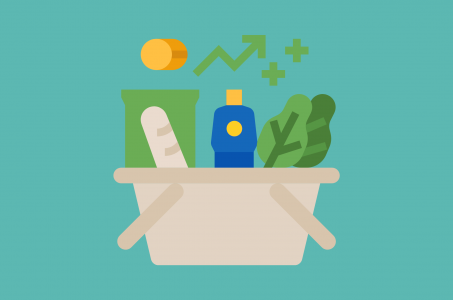This article was created in collaboration with Crayon, an online parenting and financial education database.
What’s Around The Corner: Child-related Expenses by Age and Stage
In today’s world, raising a child to the age of 18 costs us somewhere in the vicinity of $280 - $300K. That can seem like a scary lump sum, but if we break it into annual costs by age and stage it’s more palatable - and makes for much more realistic and achievable budgeting. There are also a few surprise expenses that can catch first-time parents off guard. With a bit more visibility about what you can expect, you can soundly plan for tackling these.
Let’s start with the good news: even though kids are expensive, research has found that “children have a very small impact upon wealth accumulation.” While this doesn’t take away from the financial strain many parents face, it should give you hope that you haven’t made a terrible financial choice by having a child!
The first year (age 0-1)
Childcare: $7,800
Based on the average cost of $300 per week for 50 hours of care for 6 months.
Top tip: How much you’ll actually spend on childcare in the first year of your child’s life depends on if and when you return to work. Childcare costs can range from free to over $100 per day, and many centres have waitlists, so it’s worth looking into this while you’re pregnant if returning to paid work is on the cards. If you’re on the fence about going back to work, check out our article The Economics of Returning to Work.
Baby gear: $4,500
Based on mid-range spend for essential and useful-to-have items in the Crayon Baby Gear List.
Top tip: becoming a new parent is overwhelming and it can be hard to figure out what you truly need. Your child will grow out of most of the baby gear within the first 1-2 years. In the case of clothes, your baby will likely cycle through at least three sizes in the first 12 months alone. Be thoughtful about what you need and look into buying second hand (here are Plunket’s safety tips for used baby goods).
Baby stores often have sales, but avoiding the purchase of unnecessary items is still better than “30% off”. For items you’re unsure about, do the research while you’re pregnant, note down your preferred model, and if it turns out you’d like to buy it later, it can be at your doorstep within a couple of clicks.
Nappies and wipes: $1,600
Based on mid-range nappies and wipes.
Top tip: you’ll be changing around 6,000 to 7,000 nappies until your child is potty trained, which generally happens between 2 and 3 years of age. Consider the all-in cost of reusable diapers and/or wipes, which can collectively save you $3,000 over this period of time, although you have to trade that off against your time.
Common Surprise Expenses
-
Bigger house and a larger car: new parents often find that they want more space for their growing family or to move into a more family-friendly area. SUVs are also cars of choice for families to cart baby gear around and avoid bending down every time you get your child in and out of the car.
-
Life and income insurance: the weight of financial responsibility for a baby can lead parents to putting financial safety nets in place.
-
Classes: this is an increasingly popular way for new parents to socialise and engage their child. They can add up quickly too; for example, Baby Sensory costs $175-220 per term and swimming classes are $10-20 per lesson. Many free playgroups are available.
Toddler and Pre-school (age 1-4)
Childcare: $15,600
Based on the average cost of $300 per week for 50 hours of care for 12 months.
Top tip: you may be eligible for childcare subsidies if your total family income is below $111,488 with one child, $127,400 with two children or $143,312 with three children. All children receive the 20 Hours ECE subsidy between the ages of three and five. In the 2023 Budget, the government announced that they will extend this to two year olds from 1 March 2024.
Housing: $7,800
Based on a $150 weekly difference in median rent due to moving from a 1 bedroom to 2 bedroom flat
Top tip: you may not need to upgrade your digs in the first year as parents can share their bedroom with their baby for the 6 to 12 months. However, as babies get more aware of their surroundings, many parents move them into their own room - at which point, an extra bedroom is required.
Food: $2,600
Based on the University of Otago’s report on the New Zealand Estimated Food Costs 2020 and 2021 for a child aged between 1-4 on a moderate budget, adjusted for 16% food price inflation since the end of 2021.
Top tip: it definitely pays to do some due diligence on grocery saving tips (example here). But keep in mind that the cost of food has soared 12.5% in the last 12 months, with fruit and vegetables up a whopping 22%. So, while there are tweaks you can make, the increase you’re seeing on your grocery receipt is no fault of your own.
Common Surprise Expenses
-
Babysitting fees: you might need extra cover because you need child-free time, e.g., you need to work but your child is sick and can’t go to daycare. And yes, this can also make your date night extra expensive.
-
Breakages: those little tykes can be surprisingly destructive, whether they’re breaking gadgets, drawing on walls, or damaging the floors while hooning around on a scooter.
-
Classes: like ballet, soccer or gymnastics
-
Travel: up until the age of 2, your child can ride on your plane ticket. From that point onwards though, you’ll be buying them their own seat.
Middle Childhood (age 6-12)
Housing: $7,800 (plus another $7,800 if you have two kids by now)
Based on a $150 weekly difference in median rent due to moving from a 1 bedroom to 2 bedroom flat and then from a 2 bedroom flat to 3 bedroom house.
Top tip: if you’re looking for your next place, check out Crayon’s guide to finding your family home. The number one consideration that can influence your child’s life outcomes? Your location. Also, if you have more than one child, you may want them to share a room while they’re young. Generally speaking, the recommended age for each child to have their own room is between 8 and 10, although we know that’s not an option for everyone.
After School Care and School Holiday Programs: $5,500
Based on the average after school care fees ($20 per day for 5 days/wk for 40 school weeks/yr) and the average school holiday program costs ($50 per day for 5 days per week for 6 weeks of the year).* (This assumes you and your partner use 6 weeks of annual leave between you for the other 6 weeks of school holidays).
Top tip: you may be eligible for OSCAR subsidies to help with after school care costs. Alternatively, consider if you can work flexibly some or all of the week, band together with other parents or get grandparents or whanau involved.
Food: $3,800
Based on the University of Otago’s report on the New Zealand Estimated Food Costs 2020
and 2021 for a child aged between 5-10 on a moderate budget, adjusted for 16% food price inflation since the end of 2021.
Common Surprise Expenses
-
Entertainment: this might be extra subscriptions (hello, Disney Plus at $155 per year) or family activities (e.g. a family pass for two adults and two kids will set you back $91.50 at Orana Wildlife Park, $116 at Kelly Tarltons, $129 at Weta Workshop - you get the picture).
-
Christmas, birthday parties and gifts: even for parents who aren’t OTT, the cost of attending birthday parties regularly, hosting one once a year and presents under the Christmas tree can add up quickly.
-
Activities: on top of the price of classes (sports, music, dance, drama or art) there’s also the equipment and materials, plus petrol costs to get them there.
-
Private education: Catholic schools charge compulsory attendance dues of $402.50-$626 per year for primary school students depending on your region, plus donations on top of that of $500-$1,000. Independent primary schools charge around $20,000 per year in fees. For all schools, there will also be uniforms, stationery, class trips and camps.
The Teen Years (age 13-18)
Housing: $7,800 plus another $7,800 if you have two kids now
Based on a $150 weekly difference in median rent due to moving from a 1 bedroom to 2 bedroom flat and then from a 2 bedroom flat to 3 bedroom house.
Top tip: see our top tip for Middle Childhood above
Food: $5,500 for an adolescent child
Based on the University of Otago’s report on the New Zealand Estimated Food Costs 2020
and 2021 for an adolescent child on a moderate budget, adjusted for 16% food price inflation since the end of 2021.
Top tip: see our top tip for Middle Childhood above
Transportation: No accurate estimate available
Research suggests that transport costs are the third highest cost for families with teenagers. Transport costs tend to peak when children are aged 15 to 17 because they start learning to drive and tend to participate in activities located further from home.
Top tip: Getting your teen to carpool or take public transport can reduce costs. You may also want them to fully fund or contribute to a car purchase, which is a good way to build that saving muscle.
Common Surprise Expenses
-
Medical expenses: while great medical care is available through the public system, some parents opt for private care to get their child seen to faster or to be able to choose the doctor - which is where private medical insurance can be helpful. Common procedures include tonsillectomy ($4,000-$5,600), endometriosis surgery for young women ($9,800-$18,000) and braces ($6,000-$10,000).
-
Tutoring: you may find that your child needs a bit of extra assistance outside of the classroom, with tutors costing $20-60 per hour.
-
Private education: Catholic schools charge around compulsory attendance dues of $626-$1,500 per year for secondary school students depending on your region, plus donations on top of that of around $1,200. Independent secondary schools charge around $25,000 per year in fees. For all schools, there will also be uniforms, stationery, class trips and camps.
Final Note
With a bit of planning, diligence and potentially investing it is entirely possible for children to have only a very small impact on your long term wealth accumulation. This article was not intended to scare you or put you off, but instead to help you position your family for a little less financial stress and to open up future opportunities to help your kids out.



